Club Brugge are currently top of the Belgium First Division A. The league leaders have scored the most goals, conceded the least and currently lead second place by 10 points.
This tactical analysis scout report will investigate Club Brugge to provide subjective and objective analysis on their tactics and strategies, key players and comparisons to other teams in the league to determine how Club Brugge have been so dominant this season.

The man at the helm
Before we appraise Club Brugge in terms of personnel, playing style and offer comparisons to rival teams, a look at their current manager will add some contextual information on their project.
Philippe Clement is a former Belgium international defender who also had playing spells at multiple Belgian clubs and also Coventry City in England. However, he spent the majority of his senior career, 10 years to be precise, at Club Brugge. That highlights a historical link with the club and supposes an affinity with the club staff, processes, DNA and fans.
However, in addition to his playing days at Club Brugge, Clement’s journey to manager has a more complex route. Once he retired from playing, Clement joined the scouting team at the club in 2011. He then progressed onto assistant manager and had spells in charge as caretaker between 2012 and 2017, potentially highlighting his suitability as the permanent manager at the club and demonstrating his loyalty and values match those of the club.
In 2017, Clement left to take the reins at Waasland-Beveren where he stayed for half a season before Genk came calling. Clement won the league with Genk in the 2018-19 season, but, citing issues with adding to the squad in the build-up to a Champions League campaign, Clement joined Club Brugge in the summer of 2019 as the head coach.
By analysing his success as a manager, in addition to the Belgian First Division A title in 2019, and Club Brugge’s current lead at the top of the table, Clement’s personal win percentage has improved at each club during his short career as a head coach in the league.

Tactical adaptations
As you can see from the league table image above, Club Brugge are 10 points clear at the top of the table. In addition to this, the team have won the most amount of matches, lost the fewest, scored the most and also conceded the fewest.
However, when taking a look at their typical setup, a potential reason for their continued success during the first half of the season lies in the fact that they do not have a typical setup. Club Brugge have utilised numerous tactical formations within matches, and, while formations on paper are usually flexible and differentiated during different game moments, the set formation is a useful way to assess a tactical change with a macro perspective.
| Formation | 3-5-2 | 4-1-3-2 | 4-1-4-1 | 4-3-3 | 4-2-3-1 |
| Matches Used | 8 | 3 | 5 | 2 | 2 |
From the table above, we can see that this season, Club Brugge have opted to utilise a 3-5-2 in the majority of matches, although, they frequently use a 4-1-4-1, with lesser use of a 4-1-3-2, 4-3-3 and 4-2-3-1. But, such formations are safely within the arsenal of the team for them to use from the start, or adapt into during a match to either enhance Club Brugge’s success, exploit an opposition weakness or nullify an opposition threat.
The benefit that this has is that while Club Brugge are adaptable in order to balance the positives and negatives of each system, risk and reward and react to injury and form, opposition teams cannot be sure of Club Brugge’s set up when performing opposition analysis in preparation for pre-match analysis, adaptations to training, selecting their system and identifying trends. Opposition teams will need to prepare for multiple eventualities which will decrease the detail, familiarity and understanding of each preparation plan.


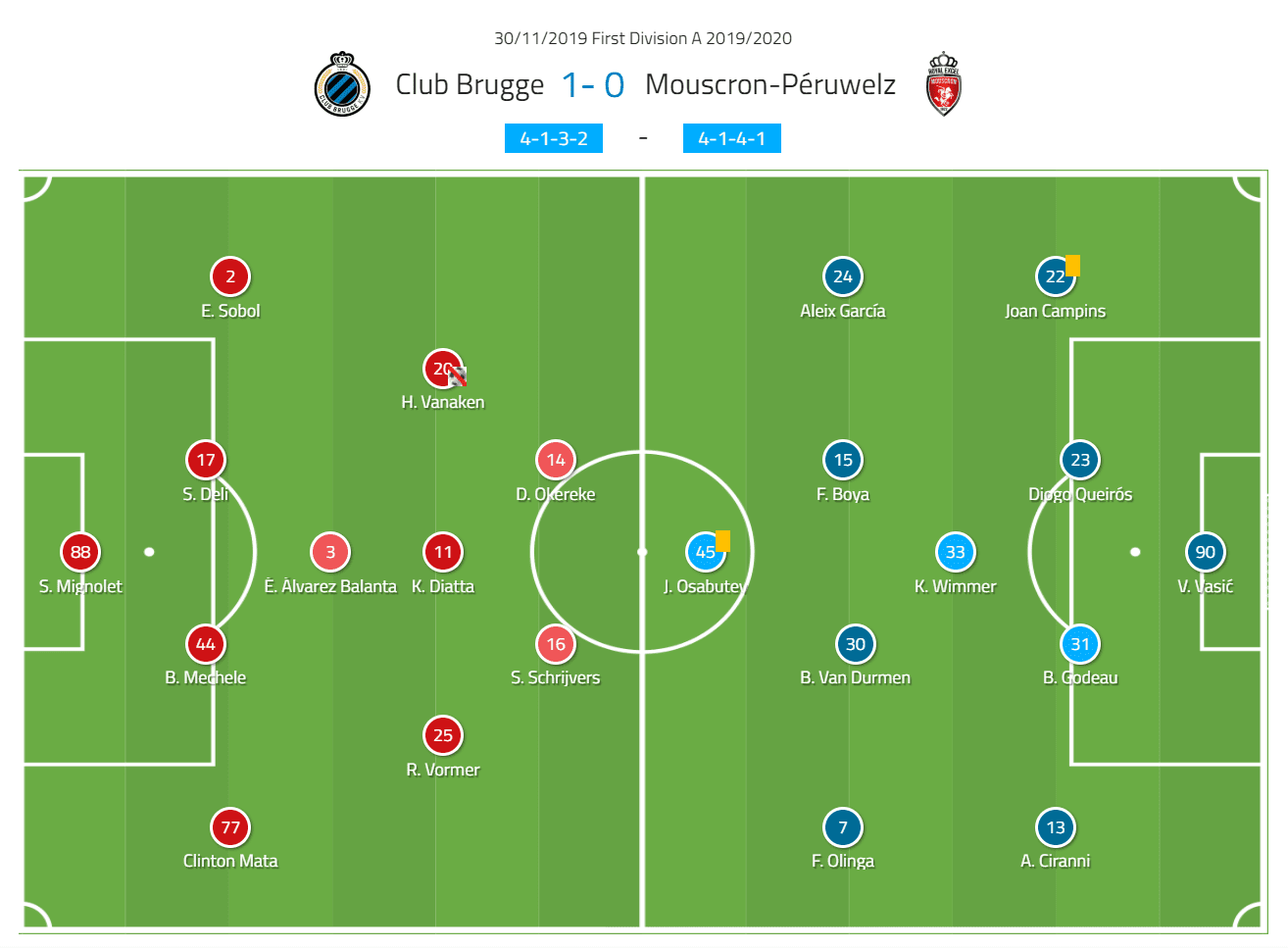
When looking at Club Brugge’s lineups in different setups above, we can see the Club Brugge have players capable of playing multiple positions and roles within the overall system. In addition to this, they have a full squad capable of fulfilling such roles with multiple different names on each team sheet, as opposed to many championship-leading sides who select the same 11 on a consistent basis within the same system. Club Brugge’s success can be attributed to a squad effort with flexibility in how they succeed in terms of setup.
Key players
Interestingly, despite scoring the most amount of goals in the league, there is no standout goalscorer which the team rely on. In the top scorer standings, Dieumerci Mbokani is top with 14 goals, then in joint fourth, both Hans Vanaken, an attacking midfielder on the left, and David Okereke, a centre-forward, feature on nine goals for Club Brugge. This highlights that both players are contributing from different areas of the pitch, as are many other players who are further down the rankings but have contributed to the team’s success in an attacking sense.
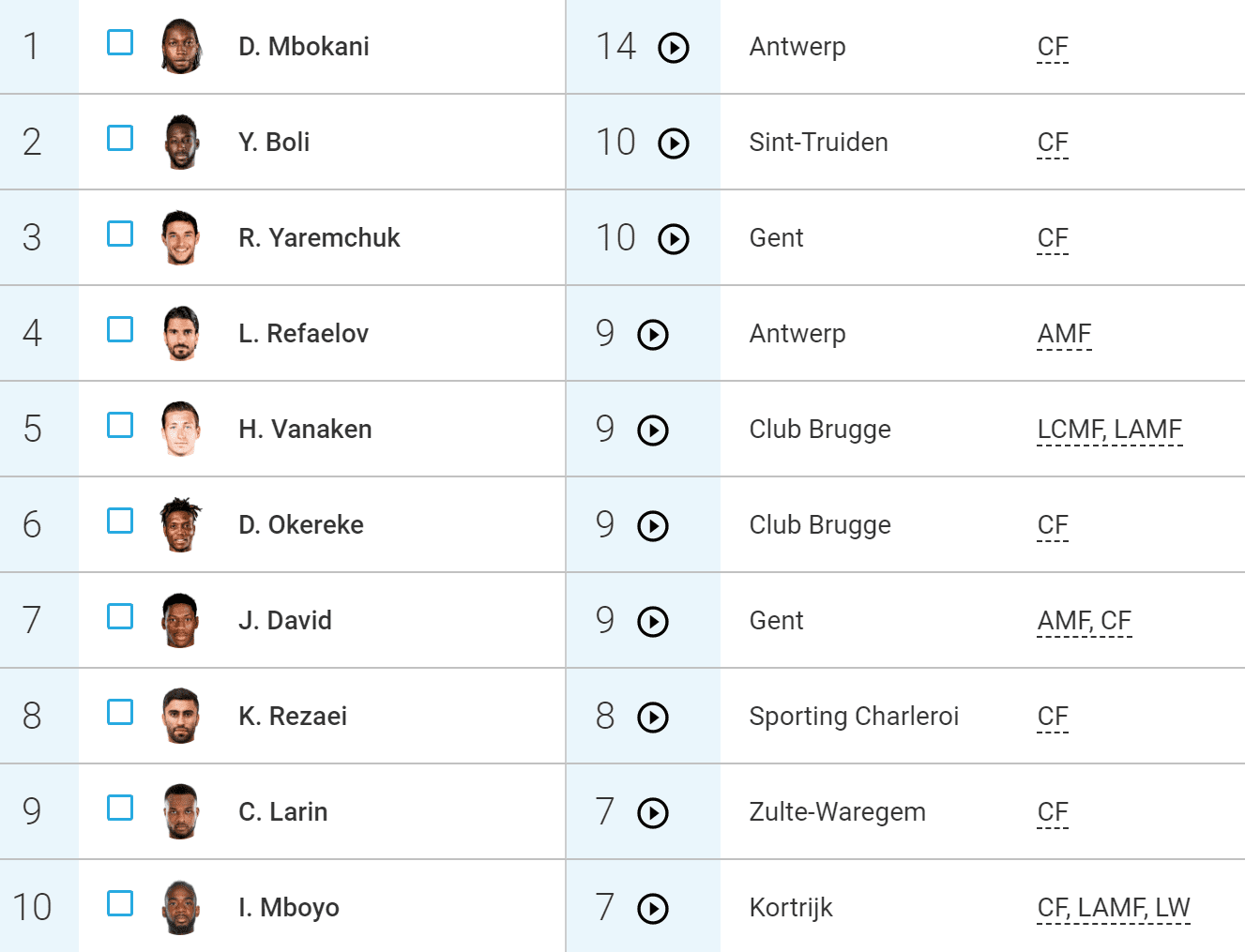
One player who Club Brugge do seemingly rely on in an attacking sense is central midfielder, Ruud Vormer. The player is frequently the team captain and therefore a key player within the dressing room and an almost constant starter in the team. The Dutchman has also racked up 12 assists, double that of the next most productive playmaker in the league. Relating his performances to the top scorers for Club Brugge, Vormer has assisted six of the 18 goals that Vanaken and Okereke have scored.
Therefore, he is responsible for creating 33% of the goal-scoring opportunities they have taken. In terms of the whole team, Vormer has assisted 12 of 46 goals, meaning he was directly involved in creating 26% of Club Brugge’s goals, clearly a large contributor in terms of creating. Vormer also takes set pieces and is therefore also a factor in allowing defenders to score when they venture up the pitch to join an attack.
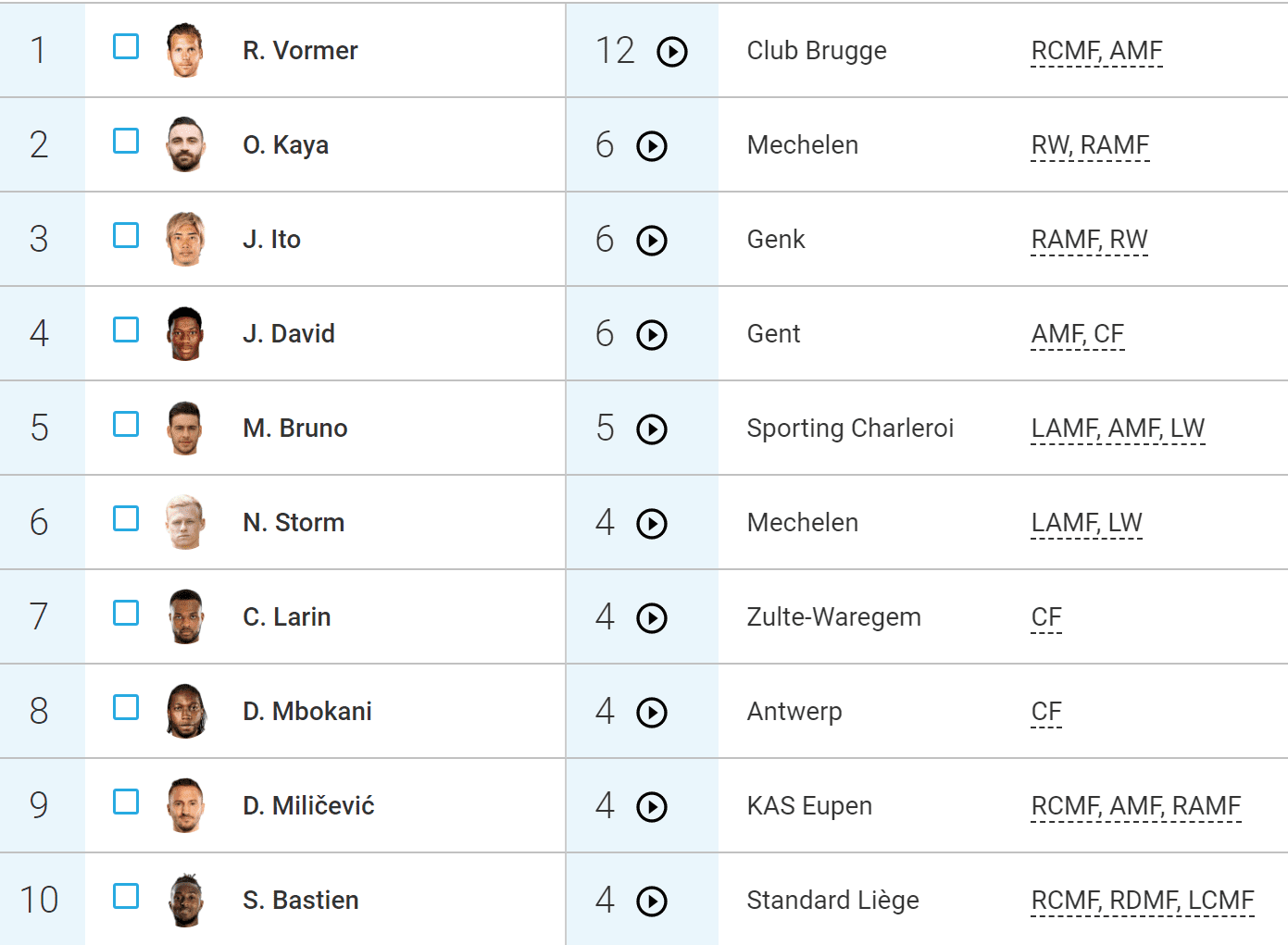
Moving towards the more defensive players within the systems, Club Brugge players do not feature in the top rankings in metrics such as the number of aerial duels, tackles, interceptions and other key defensive metrics. This is not a criticism of the individual players within the back three, or four depending on the system, but, it is more of a contextual point regarding how Club Brugge play.
This will be investigated more in sections below, however, Club Brugge are a possession dominant team, averaging 61% of possession. Given they have the ball for the majority of the time, and how they press to win the ball back quickly, Club Brugge are not going to face as many opposition attacks, long balls, one vs one dribbles or shots as other players in the league do.

To assess the defence overall, we can look at the goals conceded, eight, which is the lowest in the league, and the number of clean sheets, 13, which is the highest in the league. This pays credit to the defensive players, goalkeeper and how the team defend as a whole which will be looked into. In regards to the goalkeeper, ex-Liverpool ‘keeper, Simon Mignolet has experience and is a reliable goalkeeper behind the defence, aiding such defensive positivity.
The Club Brugge way of playing
As stated, Club Brugge keep the ball more than any other team in the league, this can be seen below.
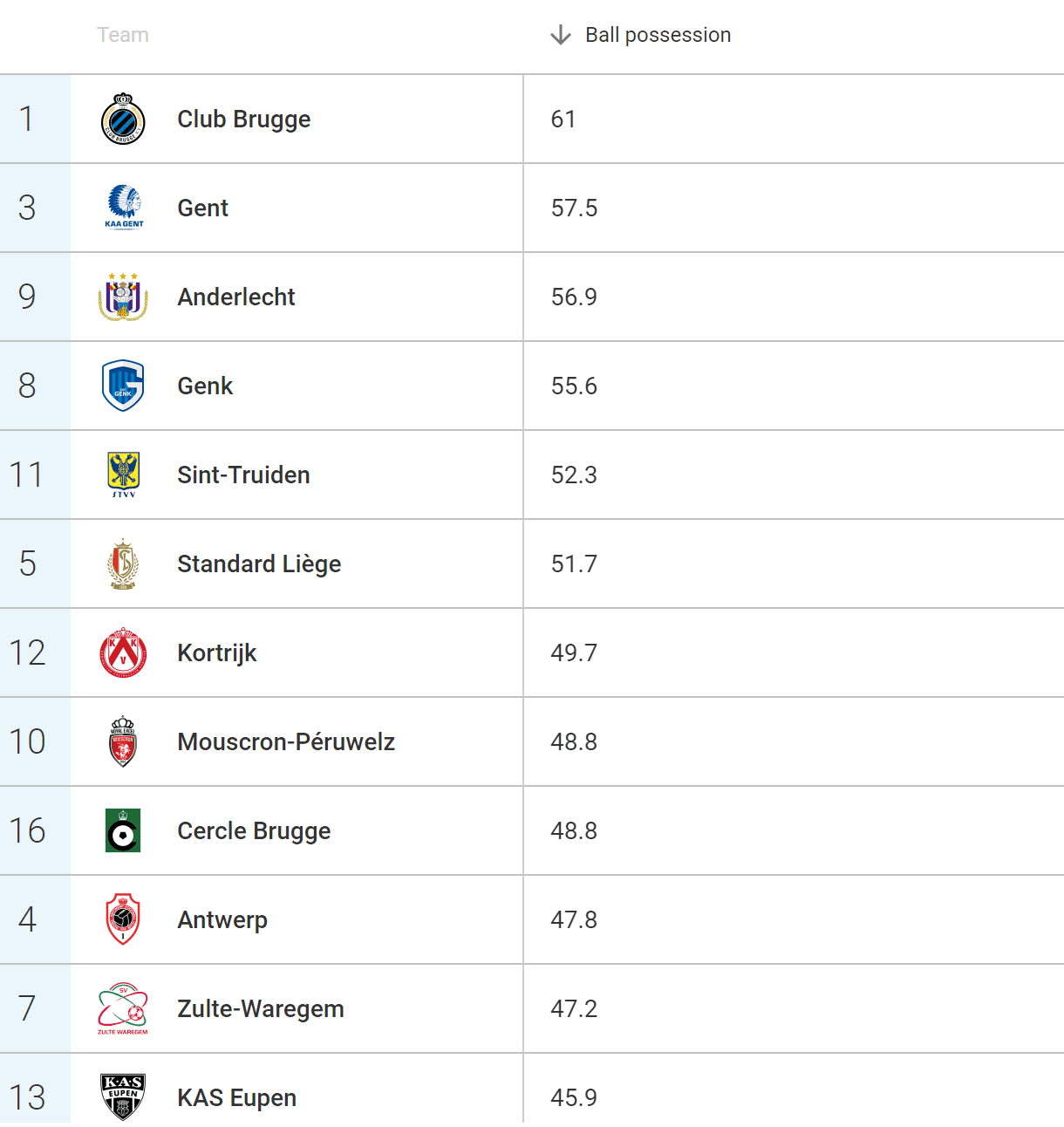
Now, if we move on to how they utilise the ball we can see that in relation to the possession, Club Brugge make the most passes per 90 minutes in the league. They are closely followed by Vincent Kompany’s Anderlecht, who has undoubtedly taken the possession dominant principles of Pep Guardiola mainly, but also Manuel Pellegrini and Roberto Mancini during his time as Manchester City captain.
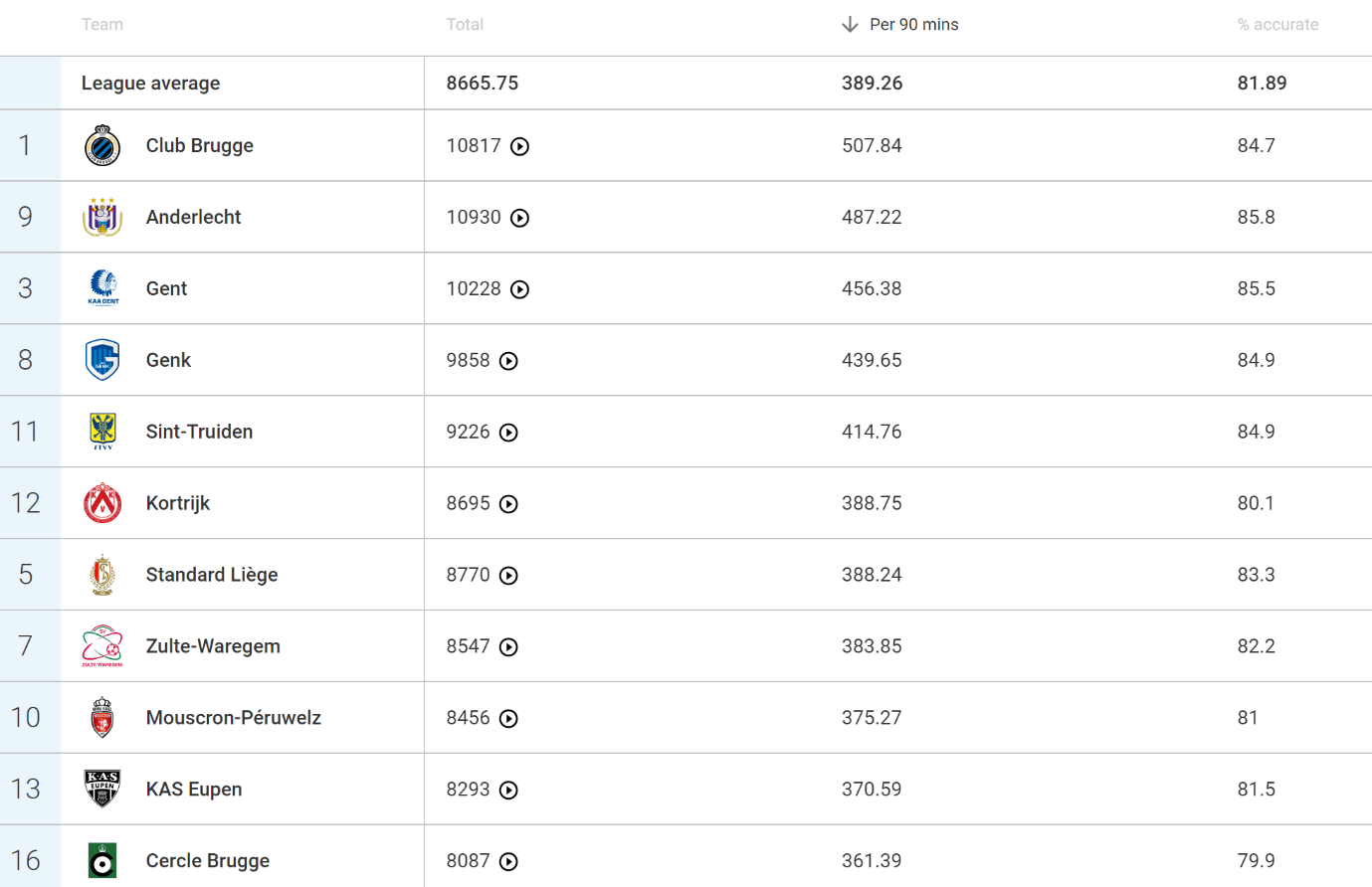
These passing stats highlight the importance of possession, dictating match tempo, progressing attacks from the back, being patient in the buildup and inviting the press in order to exploit space.
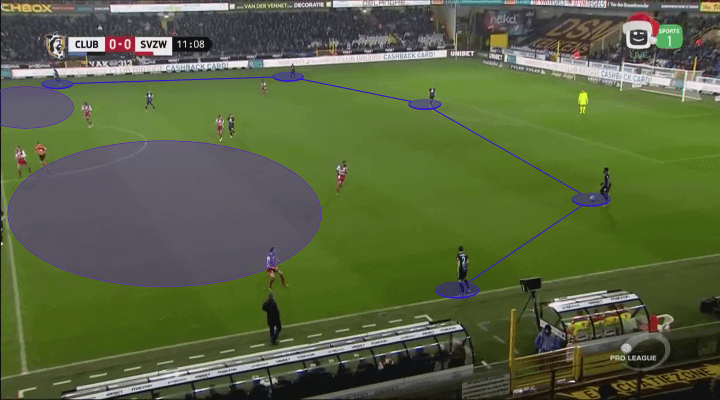
However, if we take a deeper look into the type of passes played, we can see that Club Brugge are actually towards the top of the long passing statistics in terms of the percentage of passes which are long. The league leaders are ranked third for the number of long passes per 90. This shows the adaptability of their systems.
The priority is to keep the ball, but, the team are also encouraged to exploit space via long balls behind the opposition defence, or via switches of plays in order to find a player in space, attempt to create overloads on the flanks or create space in opposing blocks by making them shift to the other side. If repeated, switches of play can cause excessive lateral movement, fatigue and lead to poor positioning or mistakes which Club Brugge could exploit.
To put this in perspective, Anderlecht are ranked 13th for their long ball percentage, highlighting that while Club Brugge play more passes and keep the ball better, they aren’t averse to playing longer passes to aid their progression. Typically, their main playmaker, Vormer, drops to collect the ball off the defence before spraying a direct pass if an option presents itself.
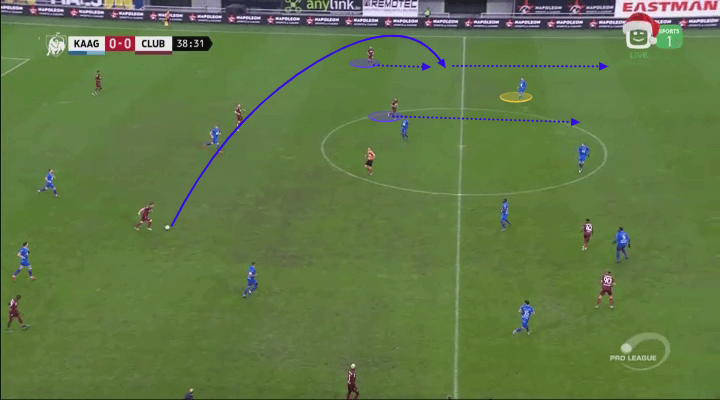
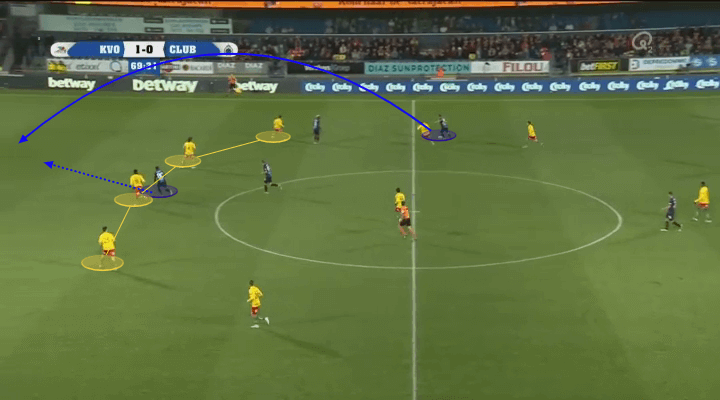
As discussed, Club Brugge can mix up their passing style. Another strong element of their systems is the wing play. Club Brugge utilise all of the pitch in order to stretch opponents. While they utilise different formations, each formation is set up to exploit the width in different ways.
In the 3-5-2, the wing-backs have reduced defensive responsibility, and with the dominance of possession, can essentially be used as wingers.
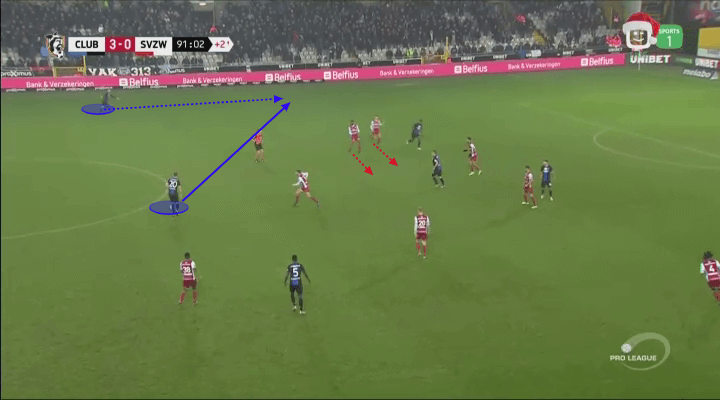
Within the 4-1-3-2, the two wider attacking midfielders can stretch the play, or stay inside and wait for overlaps from the full-backs to create two vs ones out wide.
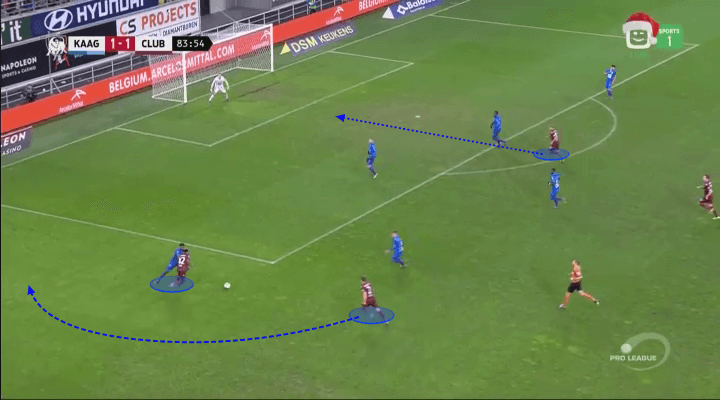
Finally, with the 4-1-4-1, the balance of that formation allows for natural width from wide midfielders, again with the full-backs able to support.
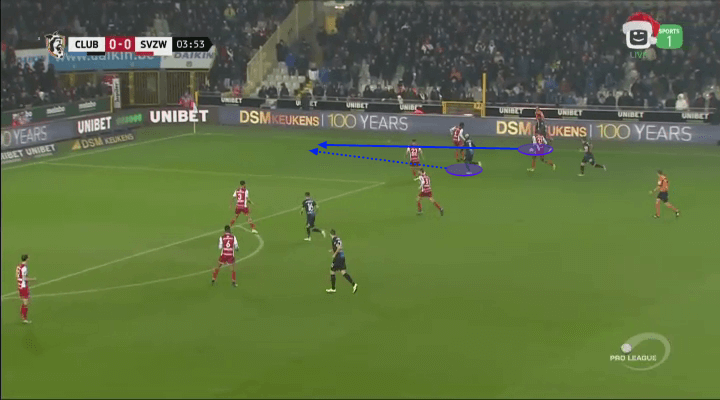
The use of width has its purpose, that purpose is crossing the ball. As in many leagues, top teams sometimes struggle to break down low blocks as teams put 10 players behind the ball in tight banks. Frequently, an effective means of bypassing this is wide play, in the sense of moving the ball wide to create central space and then trying to penetrate, or, wide play in order to create one v one dribbling opportunities or combination play in order to create space for a crossing opportunity. These examples can be witnessed in the annotated images.
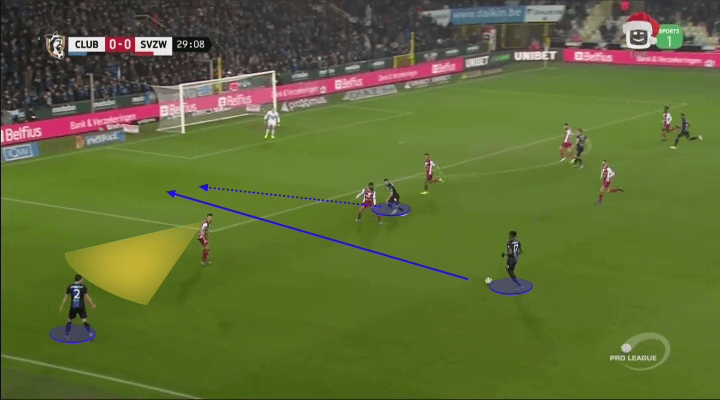
It appears that Club Brugge encourage their players to run at defenders in order to try and create crossing opportunities, as per their high rankings for crosses per 90 and dribbles per 90 below. Of course, dribbling is also important in terms of covering ground and potentially breaking a midfield or defensive line via physical and technical attributes.
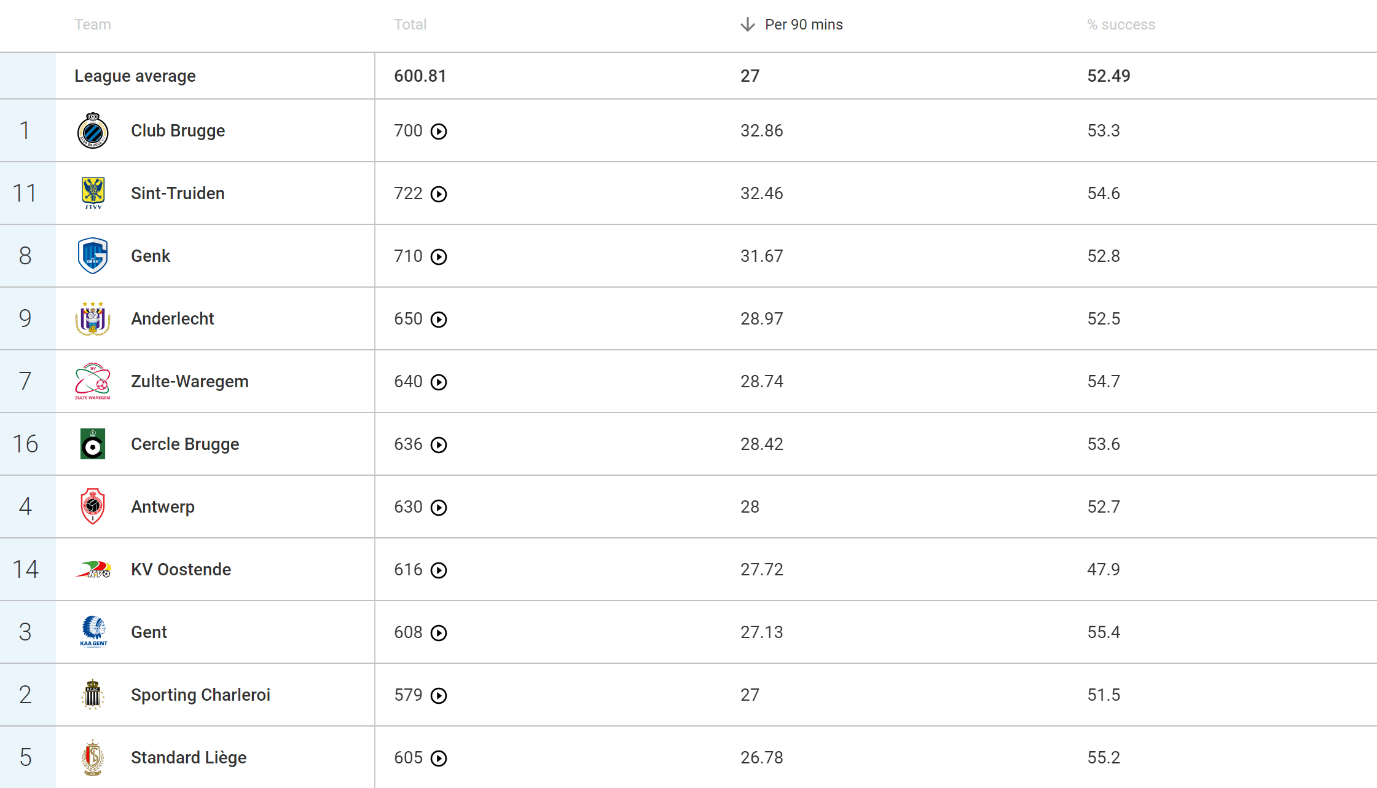

Another data metric which reinforces Club Brugge’s crossing as a means of chance creation is the number of headed shots the club has produced. The club are ranked second in the league for headed shots. Yes, Club Brugge take more shots overall than any other team, but, their numbers do show an attempt to score via headed shots from crosses due to their wing play, and set pieces from Vormer.
Finally, we need to take a look at what Club Brugge do when they don’t have the ball. Do they press intensely to win the ball back high to attack? Or do they drop back into positions and invite teams to break them down?


The data suggests Club Brugge operate using an intense press to win the ball back as quickly as possible once they lose it. This is likely due to the high positions already taken up once they lose the ball due to their domination of play. Players are likely to be in positions ready to press to stop the opposition playing by nullifying space and time, rather than retreating allowing the ball carrier time to pick a pass, potentially a direct ball into a forward over the top of a Club Brugge defence.
Although, when utilising a 3-5-2, their most common system, Club Brugge somewhat nullify this threat should a player be allowed to play a long ball or if the opposition beat the press as the central defender for Club Brugge plays slightly deeper than the other two, acting as a sweeper or covering defender when needed. Both challenge intensity and PPDA indicate how aggressively Club Brugge try to win the ball back in comparison to other teams in the league who may be more passive or focus on shape and positioning. This doesn’t mean that Club Brugge never drop back into shape to defend, but their initial instinct is to try and win the ball back quickly.
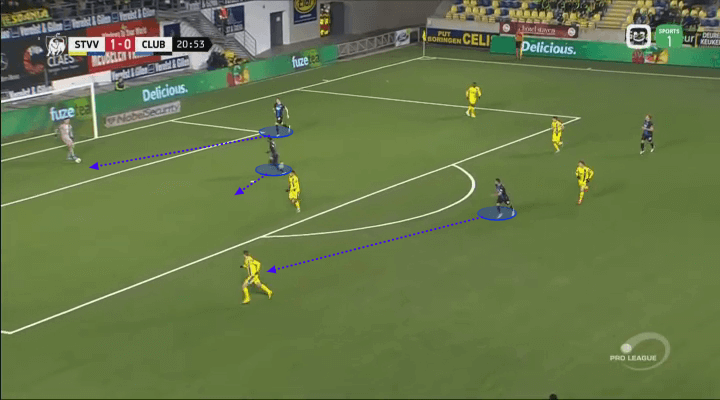
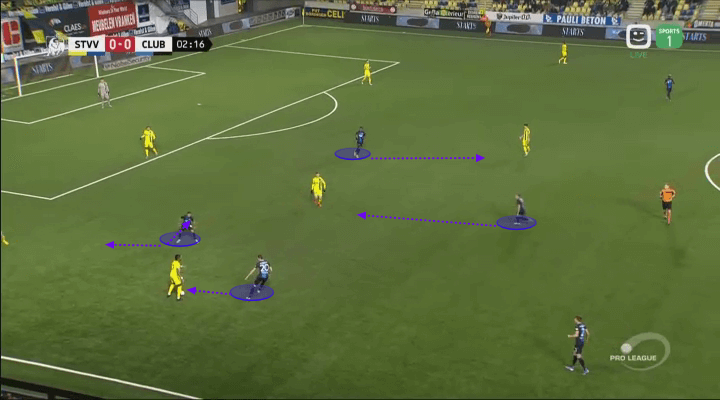
Conclusion
Overall, led by club faithful Clement, Club Brugge are the best team in Belgium this season. The data is clear with this in terms of their points gained, goals scored, goals conceded, clean sheets and many other metrics.
A deeper analysis of Club Brugge has highlighted that they are adaptable in terms of which system they use. They also utilise all of their assets in terms of squad depth and team selection. While certain players stand out as key creators and finishers, the squad shares responsibility for the majority of its success.
Club Brugge like to dominate the ball but are not averse to more direct balls when available, they play wide and attempt numerous crosses per match as a source of chance creation. When they lose the ball, they are aggressive with their opposition, suffocate their play and attempt to regain possession at a faster rather than their league rivals.
All of the above has led to a 10-point gap at the top of the table, with form and the reducing number of games remaining suggesting that the club will stay there, if not progress further away from the chasers. Unfortunately for Club Brugge, the season does not end after the regular season period, but after the championship round, meaning they will have to continue their form throughout. Although, given the form they have been in thus far, and the fact that each team starts on half of their regular-season points, it is expected, and hoped by Club Brugge, that they head into the championship round as heavy favourites.






Comments